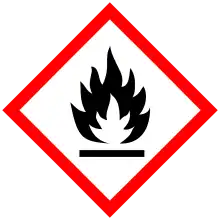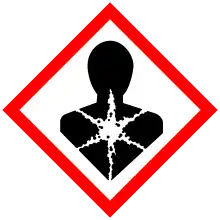 | |
-Propylene_oxide_molecule_ball.png.webp) | |
| Names | |
|---|---|
| Preferred IUPAC name
(2R)-2-Methyloxirane (2S)-2-Methyloxirane | |
| Other names
Propylene oxide Epoxypropane Propylene epoxide 1,2-Propylene oxide Methyl oxirane 1,2-Epoxypropane Propene oxide Methyl ethylene oxide Methylethylene oxide | |
| Identifiers | |
3D model (JSmol) |
|
| ChEBI | |
| ChemSpider | |
| ECHA InfoCard | 100.000.800 |
| EC Number |
|
| KEGG | |
PubChem CID |
|
| UNII | |
CompTox Dashboard (EPA) |
|
| |
| |
| Properties | |
| C3H6O | |
| Molar mass | 58.080 g·mol−1 |
| Appearance | Colourless liquid |
| Odor | benzene-like[1] |
| Density | 0.859 g/cm3[2] |
| Melting point | −111.9 °C (−169.4 °F; 161.2 K)[2] |
| Boiling point | 35 °C (95 °F; 308 K)[2] |
| 41% (20 °C)[1] | |
| Vapor pressure | 445 mmHg (20 °C)[1] |
| −4.25×10−5 cm3/mol[3] | |
Refractive index (nD) |
1.3660[2] |
| Thermochemistry | |
Heat capacity (C) |
120.4 J·(K·mol)−1 |
Std molar entropy (S⦵298) |
196.5 J·(K·mol)−1 |
Std enthalpy of formation (ΔfH⦵298) |
−123.0 kJ·mol−1[4] |
| Hazards | |
| Occupational safety and health (OHS/OSH): | |
Main hazards |
Extremely flammable[5][6] |
| GHS labelling: | |
   | |
| Danger | |
| NFPA 704 (fire diamond) | |
| Flash point | −37 °C (−35 °F; 236 K) |
| 747 °C (1,377 °F; 1,020 K) | |
| Explosive limits | 2.3–36%[1] |
| Lethal dose or concentration (LD, LC): | |
LD50 (median dose) |
660 mg/kg (guinea pig, oral) 380 mg/kg (rat, oral) 440 mg/kg (mouse, oral) 1140 mg/kg (rat, oral) 690 mg/kg (guinea pig, oral)[7] |
LC50 (median concentration) |
1740 ppm (mouse, 4 h) 4000 ppm (rat, 4 h)[7] |
LCLo (lowest published) |
2005 ppm (dog, 4 h) 4000 ppm (guinea pig, 4 h)[7] |
| NIOSH (US health exposure limits): | |
PEL (Permissible) |
TWA 100 ppm (240 mg/m3)[1] |
REL (Recommended) |
Ca[1] |
IDLH (Immediate danger) |
Ca [400 ppm][1] |
Except where otherwise noted, data are given for materials in their standard state (at 25 °C [77 °F], 100 kPa).
Infobox references | |
Propylene oxide is an acutely toxic and carcinogenic organic compound with the molecular formula CH3CHCH2O. This colourless volatile liquid with an odour similar to ether, is produced on a large scale industrially. Its major application is its use for the production of polyether polyols for use in making polyurethane plastics. It is a chiral epoxide, although it is commonly used as a racemic mixture.
This compound is sometimes called 1,2-propylene oxide to distinguish it from its isomer 1,3-propylene oxide, better known as oxetane.
Production
Industrial production of propylene oxide starts from propylene.[8] Two general approaches are employed, one involving hydrochlorination and the other involving oxidation.[9] In 2005, about half of the world production was through chlorohydrin technology and one half via oxidation routes. The latter approach is growing in importance.[10]
Hydrochlorination route
The traditional route proceeds via the conversion of propene to propylene chlorohydrin according to the following simplified scheme:
The mixture of 1-chloro-2-propanol and 2-chloro-1-propanol is then dehydrochlorinated. For example:
Lime (calcium hydroxide) is often used to absorb the HCl.
Oxidation of propylene
The other general route to propylene oxide involves oxidation of propylene with an organic peroxide. The reaction follows this stoichiometry:
- CH3CH=CH2 + RO2H → CH3CHCH2O + ROH
The process is practiced with four hydroperoxides:[10]
- In the Halcon process, t-Butyl hydroperoxide derived from oxygenation of isobutane, which affords t-butanol. This coproduct can be dehydrated to isobutene, converted to MTBE, an additive for gasoline.
- Ethylbenzene hydroperoxide, derived from oxygenation of ethylbenzene, which affords 1-phenylethanol. This coproduct can be dehydrated to give styrene, a useful monomer.
- Cumene hydroperoxide derived from oxygenation of cumene (isopropylbenzene), which affords cumyl alcohol. Via dehydration and hydrogenation this coproduct can be recycled back to cumene. This technology was commercialized by Sumitomo Chemical.[11]
- Hydrogen peroxide is the oxidant in the hydrogen peroxide to propylene oxide (HPPO) process, catalyzed by a titanium-doped silicalite:
- C3H6 + H2O2 → C3H6O + H2O
In principle, this process produces only water as a side product. In practice, some ring-opened derivatives of PO are generated.[12]
Propylene oxide is chiral building block that is commercially available in either enantiomeric form ((R)-(+) and (S)-(–)). The separated enantiomers can be obtained through a Co(III)-salen-catalyzed hydrolytic kinetic resolution of the racemic material.[13]
Reactions
Like other epoxides, PO undergoes ring-opening reactions. With water, propylene glycol is produced. With alcohols, reactions, called hydroxylpropylation, analogous to ethoxylation occur. Grignard reagents add to propylene oxide to give secondary alcohols.
Some other reactions of propylene oxide include:[14]
- Reaction with aluminium oxide at 250–260 °C leads to propionaldehyde and a little acetone.
- Reaction with silver(I) oxide leads to acetic acid.
- Reaction with sodium–mercury amalgam and water leads to isopropanol.
Uses
Between 60 and 70% of all propylene oxide is converted to polyether polyols by the process called alkoxylation.[15] These polyols are building blocks in the production of polyurethane plastics.[16] About 20% of propylene oxide is hydrolyzed into propylene glycol, via a process which is accelerated by acid or base catalysis. Other major products are polypropylene glycol, propylene glycol ethers, and propylene carbonate.
Niche uses
Fumigant
The United States Food and Drug Administration has approved the use of propylene oxide to pasteurize raw almonds beginning on September 1, 2007, in response to two incidents of contamination by Salmonella in commercial orchards, one incident occurring in Canada and one in the United States.[17][18] Pistachio nuts can also be subjected to propylene oxide to control Salmonella.
Microscopy
Propylene oxide is commonly used in the preparation of biological samples for electron microscopy, to remove residual ethanol previously used for dehydration. In a typical procedure, the sample is first immersed in a mixture of equal volumes of ethanol and propylene oxide for 5 minutes, and then four times in pure oxide, 10 minutes each.
Munition
Propylene oxide is sometimes used in thermobaric munitions as the fuel in fuel–air explosives. In addition to the explosive damage from the blast wave, unexploded propylene oxide can cause additional effects from direct toxicity.[19]
Safety
Propylene oxide is both acutely toxic and carcinogenic. Acute exposure causes respiratory tract irritation, eventually leading to death.[20] Signs of toxicity after acute exposure include salivation, lacrimation, nasal discharge, gasping, lethargy and hypoactivity, weakness, and incoordination. Propylene oxide is also neurotoxic in rats, and presumably in humans [21]
Propylene oxide alkylates DNA.[22] As such, it is known animal carcinogen[23] and a potential human carcinogen, and is included into the List of IARC Group 2B carcinogens.[24]
Natural occurrence
In 2016 it was reported that propylene oxide was detected in Sagittarius B2, a cloud of gas in the Milky Way weighing three million solar masses. It is the first chiral molecule to be detected in space, albeit with no enantiomeric excess.[25]
References
- 1 2 3 4 5 6 7 NIOSH Pocket Guide to Chemical Hazards. "#0538". National Institute for Occupational Safety and Health (NIOSH).
- 1 2 3 4 Haynes 2011, p. 3.384
- ↑ Haynes 2011, p. 3.577
- ↑ Haynes 2011, p. 5.24
- ↑ "NFPA DIAMOND". www.otrain.com.
- ↑ GOV, NOAA Office of Response and Restoration, US. "PROPYLENE OXIDE | CAMEO Chemicals | NOAA". cameochemicals.noaa.gov.
- 1 2 3 "Propylene oxide". Immediately Dangerous to Life or Health Concentrations (IDLH). National Institute for Occupational Safety and Health (NIOSH).
- ↑ Nijhuis TA, Makkee M, Moulijn JA, Weckhuysen BM (2006). "The Production of Propene Oxide: Catalytic Processes and Recent Developments". Industrial & Engineering Chemistry Research. 45 (10): 3447–3459. doi:10.1021/ie0513090. hdl:1874/20149.
- ↑ Kahlich D, Wiechern U, Lindner J. "Propylene Oxide". Ullmann's Encyclopedia of Industrial Chemistry. Weinheim: Wiley-VCH. doi:10.1002/14356007.a22_239. ISBN 978-3527306732.
- 1 2 Nijhuis TA, Makkee M, Moulijn JA, Weckhuysen BM (2006). "The Production of Propene Oxide: Catalytic Processes and Recent Developments". Industrial & Engineering Chemistry Research. 45 (10): 3447. doi:10.1021/ie0513090. hdl:1874/20149.
- ↑ "Summary of Sumitomo process from Nexant Reports". Archived from the original on 2006-01-17. Retrieved 2007-09-18.
- ↑ Russo V, Tesser R, Santacesaria E, Di Serio M (2013). "Chemical and Technical Aspects of Propene Oxide Production via Hydrogen Peroxide (HPPO Process)". Industrial & Engineering Chemistry Research. 52 (3): 1168–1178. doi:10.1021/ie3023862.
- ↑ Schaus, Scott E.; Brandes, Bridget D.; Larrow, Jay F.; Tokunaga, Makoto; Hansen, Karl B.; Gould, Alexandra E.; Furrow, Michael E.; Jacobsen, Eric N. (2002-02-01). "Highly Selective Hydrolytic Kinetic Resolution of Terminal Epoxides Catalyzed by Chiral (salen)Co III Complexes. Practical Synthesis of Enantioenriched Terminal Epoxides and 1,2-Diols". Journal of the American Chemical Society. 124 (7): 1307–1315. doi:10.1021/ja016737l. ISSN 0002-7863.
- ↑ Heilbron I, ed. (1953). Dictionary of Organic Compounds. Vol. 4. Oxford University Press. p. 249.
- ↑ Adam N, Avar G, Blankenheim H, Friedrichs W, Giersig M, Weigang E, et al. "Polyurethanes". Ullmann's Encyclopedia of Industrial Chemistry. Weinheim: Wiley-VCH. doi:10.1002/14356007.a21_665.pub2. ISBN 978-3527306732.
- ↑ "Usage of proplyene oxide". Dow Chemical. Archived from the original on 2007-09-15. Retrieved 2007-09-10.
- ↑ "Guidance for Industry: Measures to Address the Risk for Contamination by Salmonella Species in Food Containing a Pistachio-Derived Product As An Ingredient; Draft Guidance". fda.gov. June 2009. Archived from the original on 2011-02-09.
- ↑ Agricultural Marketing Service, USDA (30 March 2007). "Almonds Grown in California; Outgoing Quality Control Requirements" (PDF). Federal Register. 72 (61): 15, 021–15, 036. Archived from the original (PDF) on 28 September 2007. Retrieved 2007-08-22.
- ↑ "Backgrounder on Russian Fuel Air Explosives ("Vacuum Bombs") | Human Rights Watch". Hrw.org. February 1, 2000. Archived from the original on February 10, 2013. Retrieved April 23, 2013.
- ↑ National Research Council (US) Committee on Acute Exposure Guideline Levels (2010). Acute Exposure Guideline Levels for Selected Airborne Chemicals: Volume 9. National Academies Press.
- ↑ Ohnishi A, Murai Y (February 1993). "Polyneuropathy due to ethylene oxide, propylene oxide, and butylene oxide". Environmental Research. 60 (2): 242–247. doi:10.1006/enrs.1993.1032. PMID 8472653.
- ↑ Lawley PD, Jarman M (February 1972). "Alkylation by propylene oxide of deoxyribonucleic acid, adenine, guanosine and deoxyguanylic acid". The Biochemical Journal. 126 (4): 893–900. doi:10.1042/bj1260893. PMC 1178497. PMID 5073240.
- ↑ Ringo DL, Brennan EF, Cota-Robles EH (September 1982). "Epoxy resins are mutagenic: implications for electron microscopists". Journal of Ultrastructure Research. 80 (3): 280–287. doi:10.1016/s0022-5320(82)80041-5. PMID 6752439.
- ↑ Grana R, Benowitz N, Glantz SA (May 2014). "E-cigarettes: a scientific review". Circulation. 129 (19): 1972–1986. doi:10.1161/circulationaha.114.007667. PMC 4018182. PMID 24821826.
- ↑ "Scientists just detected this life-forming molecule in interstellar space for the first time". Science Alert. 2016-06-15.
Cited sources
- Haynes WM, ed. (2011). CRC Handbook of Chemistry and Physics (92nd ed.). Boca Raton, FL: CRC Press. ISBN 1-4398-5511-0.
External links
- WebBook page for C3H6O
- Propylene oxide at the United States Environmental Protection Agency
- Propylene oxide – chemical product info: properties, production, applications.
- Propylene oxide at the Technology Transfer Network Air Toxics Web Site
- CDC – NIOSH Pocket Guide to Chemical Hazards
